Effect of Defects Part II: Multiscale Effect of Microvoids, Orientation of Rivet Holes on the Damage Propagation, and Ultimate Failure Strength of Composites
Abstract
1. Introduction
2. Peridynamic Theory and Numerical Simulations
3. Results
3.1. Geometry of the Problem
3.2. Peridynamic Simulation
3.3. Validation
3.4. Quantifying the Strength of the UD Plate with One Hole in the Presence of Microvoid (Effect of Microscale Defects)
4. Conclusions
Author Contributions
Funding
Institutional Review Board Statement
Data Availability Statement
Conflicts of Interest
References
- Seydibeyoglu, M.O.; Mohanty, A.K.; Misra, M. Fiber Technology for Fiber-Reinforced Composites; Woodhead Publishing: Shaston, UK, 2017. [Google Scholar]
- Patterson, E.; Backman, D.; Cloud, G. Composite Materials and Joining Technologies for Composites, Volume 7: Proceedings of the 2012 Annual Conference on Experimental and Applied Mechanics; Springer Science & Business Media: Berlin/Heidelberg, Germany, 2012; Volume 44. [Google Scholar]
- Choi, J.-H.; Chun, Y.-J. Failure load prediction of mechanically fastened composite joints. J. Compos. Mater. 2003, 37, 2163–2177. [Google Scholar] [CrossRef]
- Toubal, L.; Karama, M.; Lorrain, B. Stress concentration in a circular hole in composite plate. Compos. Struct. 2005, 68, 31–36. [Google Scholar] [CrossRef]
- Khechai, A.; Tati, A.; Guettala, A. Finite element analysis of stress concentrations and failure criteria in composite plates with circular holes. Front. Mech. Eng. 2014, 9, 281–294. [Google Scholar] [CrossRef]
- Jafari, M.; Ardalani, E. Stress concentration in finite metallic plates with regular holes. Int. J. Mech. Sci. 2016, 106, 220–230. [Google Scholar] [CrossRef]
- Özaslan, E.; Güler, M.; Yetgin, A.; Acar, B. Stress analysis and strength prediction of composite laminates with two interacting holes. Compos. Struct. 2019, 221, 110869. [Google Scholar] [CrossRef]
- Huang, T.; Gong, Y. A multiscale analysis for predicting the elastic properties of 3D woven composites containing void defects. Compos. Struct. 2018, 185, 401–410. [Google Scholar] [CrossRef]
- Whitney, J.M.; Nuismer, R. Stress fracture criteria for laminated composites containing stress concentrations. J. Compos. Mater. 1974, 8, 253–265. [Google Scholar] [CrossRef]
- Eriksson, I.; Aronsson, C.-G. Strength of tensile loaded graphite/epoxy laminates containing cracks, open and filled holes. J. Compos. Mater. 1990, 24, 456–482. [Google Scholar] [CrossRef]
- Niesłony, A.; Böhm, M. Application of spectral method in fatigue life assessment–determination of crack initiation. J. Theor. Appl. Mech. 2012, 50, 819–829. [Google Scholar]
- Liu, W.; Chang, X.; Zhang, X.; Zhang, Y. Progressive damage analysis of carbon/epoxy laminates under couple laser and mechanical loading. Results Phys. 2017, 7, 995–1005. [Google Scholar] [CrossRef]
- Tan, S.C.; Perez, J. Progressive failure of laminated composites with a hole under compressive loading. J. Reinf. Plast. Compos. 1993, 12, 1043–1057. [Google Scholar] [CrossRef]
- Riccio, A.; Pietropaoli, E. Modeling damage propagation in composite plates with embedded delamination under compressive load. J. Compos. Mater. 2008, 42, 1309–1335. [Google Scholar] [CrossRef]
- Hufner, D.R.; Accorsi, M.L. A progressive failure theory for woven polymer-based composites subjected to dynamic loading. Compos. Struct. 2009, 89, 177–185. [Google Scholar] [CrossRef]
- Moure, M.; Otero, F.; García-Castillo, S.; Sánchez-Sáez, S.; Barbero, E.; Barbero, E. Damage evolution in open-hole laminated composite plates subjected to in-plane loads. Compos. Struct. 2015, 133, 1048–1057. [Google Scholar] [CrossRef]
- Moure, M.; García-Castillo, S.; Sánchez-Sáez, S.; Barbero, E.; Barbero, E. Influence of ply cluster thickness and location on matrix cracking evolution in open-hole composite laminates. Compos. Part B Eng. 2016, 95, 40–47. [Google Scholar] [CrossRef]
- Achard, V.; Bouvet, C.; Castanié, B.; Chirol, C. Discrete ply modelling of open hole tensile tests. Compos. Struct. 2014, 113, 369–381. [Google Scholar] [CrossRef]
- Zou, P.; Chen, X.; Chen, H.; Xu, G. Damage propagation and strength prediction of a single-lap interference-fit laminate structure. Front. Mech. Eng. 2020, 15, 558–570. [Google Scholar] [CrossRef]
- Rozylo, P.; Ferdynus, M.; Debski, H.; Samborski, S. Progressive failure analysis of thin-walled composite structures verified experimentally. Materials 2020, 13, 1138. [Google Scholar] [CrossRef]
- Rozylo, P. Experimental-numerical study into the stability and failure of compressed thin-walled composite profiles using progressive failure analysis and cohesive zone model. Compos. Struct. 2021, 257, 113303. [Google Scholar] [CrossRef]
- Ridha, M.; Wang, C.; Chen, B.; Tay, T. Modelling complex progressive failure in notched composite laminates with varying sizes and stacking sequences. Compos. Part A Appl. Sci. Manuf. 2014, 58, 16–23. [Google Scholar] [CrossRef]
- Pinho, S.; Iannucci, L.; Robinson, P. Physically-based failure models and criteria for laminated fibre-reinforced composites with emphasis on fibre kinking: Part I: Development. Compos. Part A Appl. Sci. Manuf. 2006, 37, 63–73. [Google Scholar] [CrossRef]
- Maimí, P.; Camanho, P.P.; Mayugo, J.; Dávila, C. A continuum damage model for composite laminates: Part I–Constitutive model. Mech. Mater. 2007, 39, 897–908. [Google Scholar] [CrossRef]
- Maimí, P.; Camanho, P.P.; Mayugo, J.; Dávila, C. A continuum damage model for composite laminates: Part II–Computational implementation and validation. Mech. Mater. 2007, 39, 909–919. [Google Scholar] [CrossRef]
- Belytschko, T.; Black, T. Elastic crack growth in finite elements with minimal remeshing. Int. J. Numer. Methods Eng. 1999, 45, 601–620. [Google Scholar] [CrossRef]
- Moës, N.; Dolbow, J.; Belytschko, T. A finite element method for crack growth without remeshing. Int. J. Numer. Methods Eng. 1999, 46, 131–150. [Google Scholar] [CrossRef]
- Higuchi, R.; Okabe, T.; Nagashima, T. Numerical simulation of progressive damage and failure in composite laminates using XFEM/CZM coupled approach. Compos. Part A Appl. Sci. Manuf. 2017, 95, 197–207. [Google Scholar] [CrossRef]
- Van Dongen, B.; van Oostrum, A.; Zarouchas, D. A blended continuum damage and fracture mechanics method for progressive damage analysis of composite structures using XFEM. Compos. Struct. 2018, 184, 512–522. [Google Scholar] [CrossRef]
- Silling, S.A. Reformulation of elasticity theory for discontinuities and long-range forces. J. Mech. Phys. Solids 2000, 48, 175–209. [Google Scholar] [CrossRef]
- Silling, S.A.; Epton, M.; Weckner, O.; Xu, J.; Askari, E. Peridynamic states and constitutive modeling. J. Elast. 2007, 88, 151–184. [Google Scholar] [CrossRef]
- Oterkus, E.; Barut, A.; Madenci, E. Damage growth prediction from loaded composite fastener holes by using peridynamic theory. In Proceedings of the 51st AIAA/ASME/ASCE/AHS/ASC Structures, Structural Dynamics, and Materials Conference 18th AIAA/ASME/AHS Adaptive Structures Conference 12th, Orlando, FL, USA, 12–15 April 2010; p. 3026. [Google Scholar]
- Oterkus, E.; Madenci, E. Peridynamic analysis of fiber-reinforced composite materials. J. Mech. Mater. Struct. 2012, 7, 45–84. [Google Scholar] [CrossRef]
- Taştan, A.; Yolum, U.; Güler, M.; Zaccariotto, M.; Galvanetto, U. A 2D Peridynamic Model for Failure Analysis of Orthotropic Thin Plates Due to Bending. Procedia Struct. Integr. 2016, 2, 261–268. [Google Scholar] [CrossRef]
- Yu, Y.; Wang, H. Peridynamic analytical method for progressive damage in notched composite laminates. Compos. Struct. 2014, 108, 801–810. [Google Scholar]
- Colavito, K.; Barut, A.; Madenci, E.; Phan, N. Residual strength of composite laminates with a hole by using peridynamic theory. In Proceedings of the 54th AIAA/ASME/ASCE/AHS/ASC Structures, Structural Dynamics, and Materials Conference, Boston, MA, USA, 8–11 April 2013; p. 1761. [Google Scholar]
- Hu, Y.; Madenci, E. Bond-based peridynamic modeling of composite laminates with arbitrary fiber orientation and stacking sequence. Compos. Struct. 2016, 153, 139–175. [Google Scholar] [CrossRef]
- Hu, Y.; Madenci, E. Peridynamics for fatigue life and residual strength prediction of composite laminates. Compos. Struct. 2017, 160, 169–184. [Google Scholar] [CrossRef]
- Huang, H.; Talreja, R. Effects of void geometry on elastic properties of unidirectional fiber reinforced composites. Compos. Sci. Technol. 2005, 65, 1964–1981. [Google Scholar] [CrossRef]
- Hyde, A.; He, J.; Cui, X.; Lua, J.; Liu, L. Effects of microvoids on strength of unidirectional fiber-reinforced composite materials. Compos. Part B Eng. 2020, 187, 107844. [Google Scholar] [CrossRef]
- Tavaf, V.; Saadatzi, M.; Banerjee, S. Quantification of degraded constitutive coefficients of composites in the presence of distributed defects. J. Compos. Mater. 2019, 53, 2517–2529. [Google Scholar] [CrossRef]
- Tavaf, V.; Saadatzi, M.; Shrestha, S.; Banerjee, S. Quantification of material degradation and its behavior of elastodynamic Green’s function for computational wave field modeling in composites. Mater. Today Commun. 2018, 17, 402–412. [Google Scholar] [CrossRef]
- Gao, X.; Yuan, L.; Fu, Y.; Yao, X.; Yang, H. Prediction of mechanical properties on 3D braided composites with void defects. Compos. Part B Eng. 2020, 108164. [Google Scholar] [CrossRef]
- Chao, X.; Qi, L.; Tian, W.; Hou, X.; Ma, W.; Li, H. Numerical evaluation of the influence of porosity on bending properties of 2D carbon/carbon composites. Compos. Part B Eng. 2018, 136, 72–80. [Google Scholar] [CrossRef]
- Qi, L.; Chao, X.; Tian, W.; Ma, W.; Li, H. Numerical study of the effects of irregular pores on transverse mechanical properties of unidirectional composites. Compos. Sci. Technol. 2018, 159, 142–151. [Google Scholar] [CrossRef]
- Roy, P.; Deepu, S.; Pathrikar, A.; Roy, D.; Reddy, J. Phase field based peridynamics damage model for delamination of composite structures. Compos. Struct. 2017, 180, 972–993. [Google Scholar] [CrossRef]
- Bai, Y.; Zhang, X.-Z. Progressive failure analysis of open-hole composite hoops under radial loading. Compos. Part B Eng. 2016, 97, 336–343. [Google Scholar] [CrossRef]
- Bao, H.; Liu, G. Progressive failure analysis on scaled open-hole tensile composite laminates. Compos. Struct. 2016, 150, 173–180. [Google Scholar] [CrossRef]
- Khechai, A.; Tati, A.; Guerira, B.; Guettala, A.; Mohite, P. Strength degradation and stress analysis of composite plates with circular, square and rectangular notches using digital image correlation. Compos. Struct. 2018, 185, 699–715. [Google Scholar] [CrossRef]
- Silling, S.A.; Askari, E. A meshfree method based on the peridynamic model of solid mechanics. Comput. Struct. 2005, 83, 1526–1535. [Google Scholar] [CrossRef]
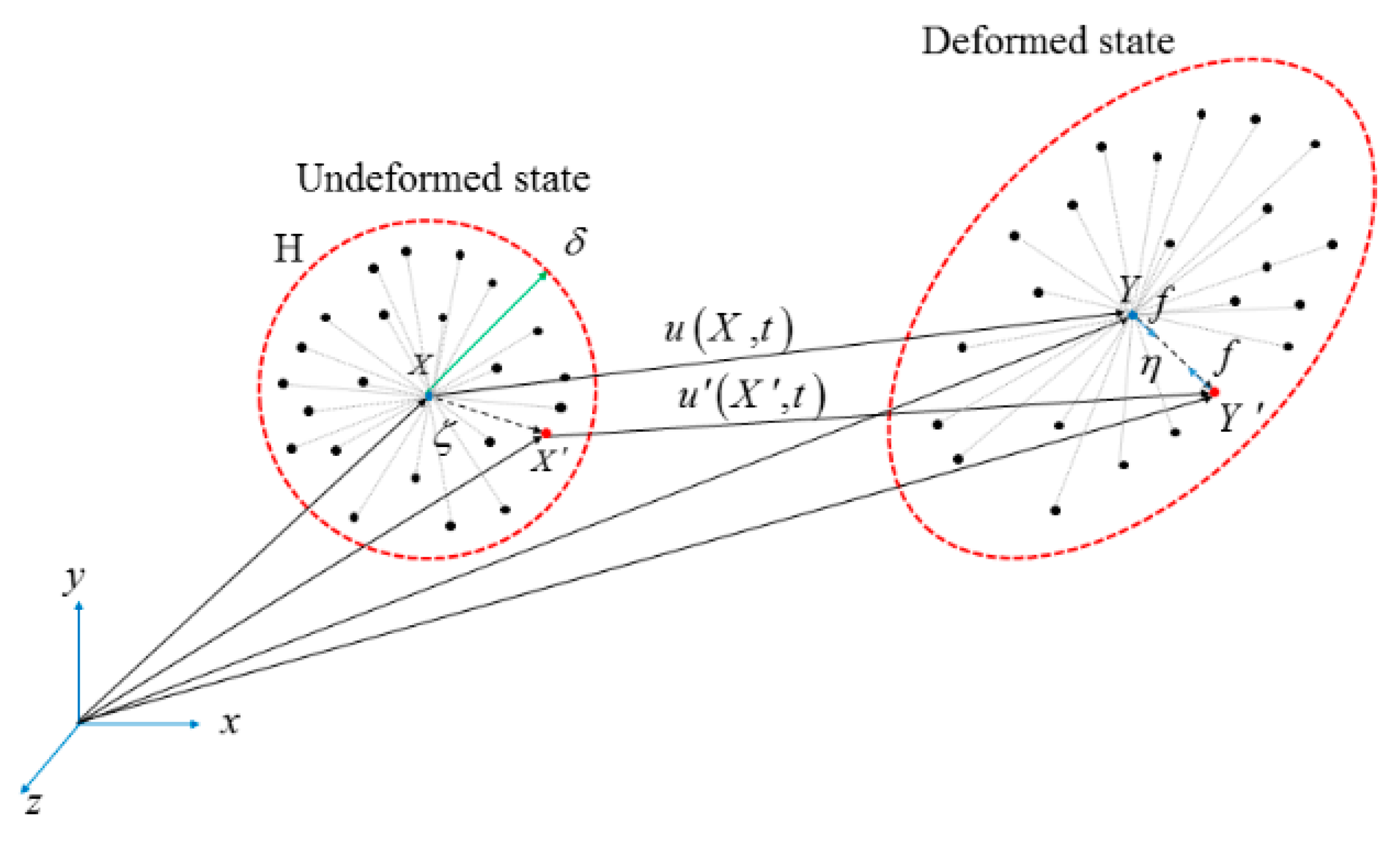



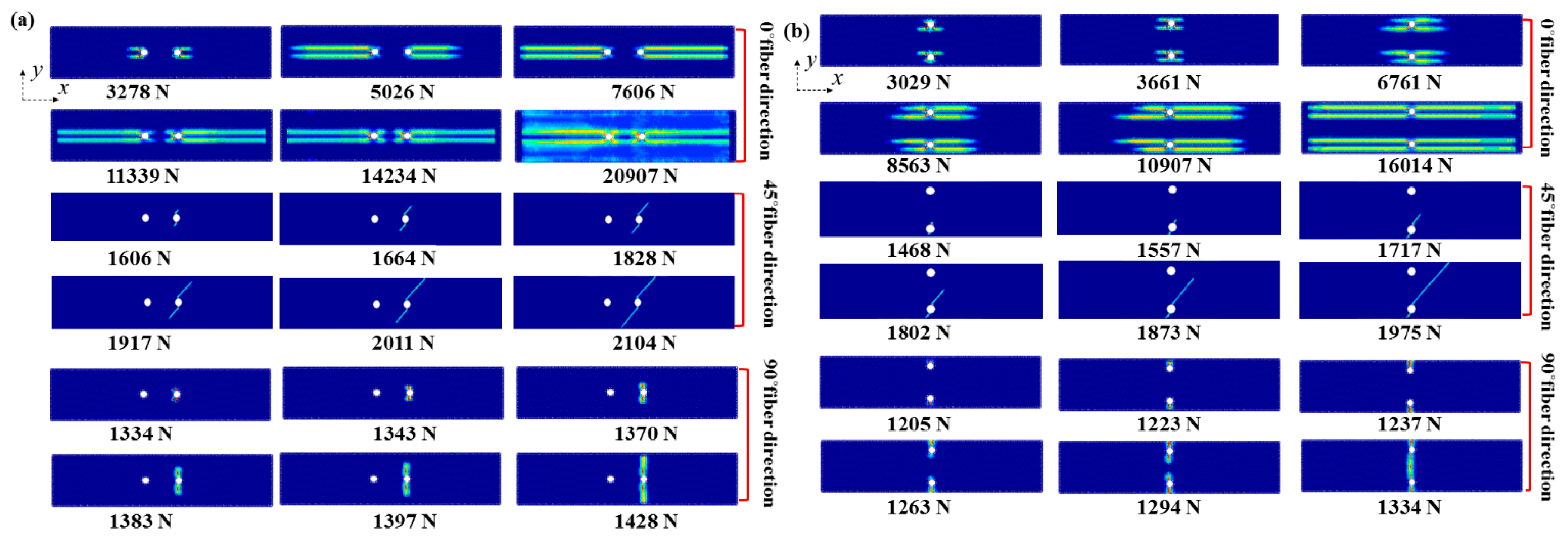


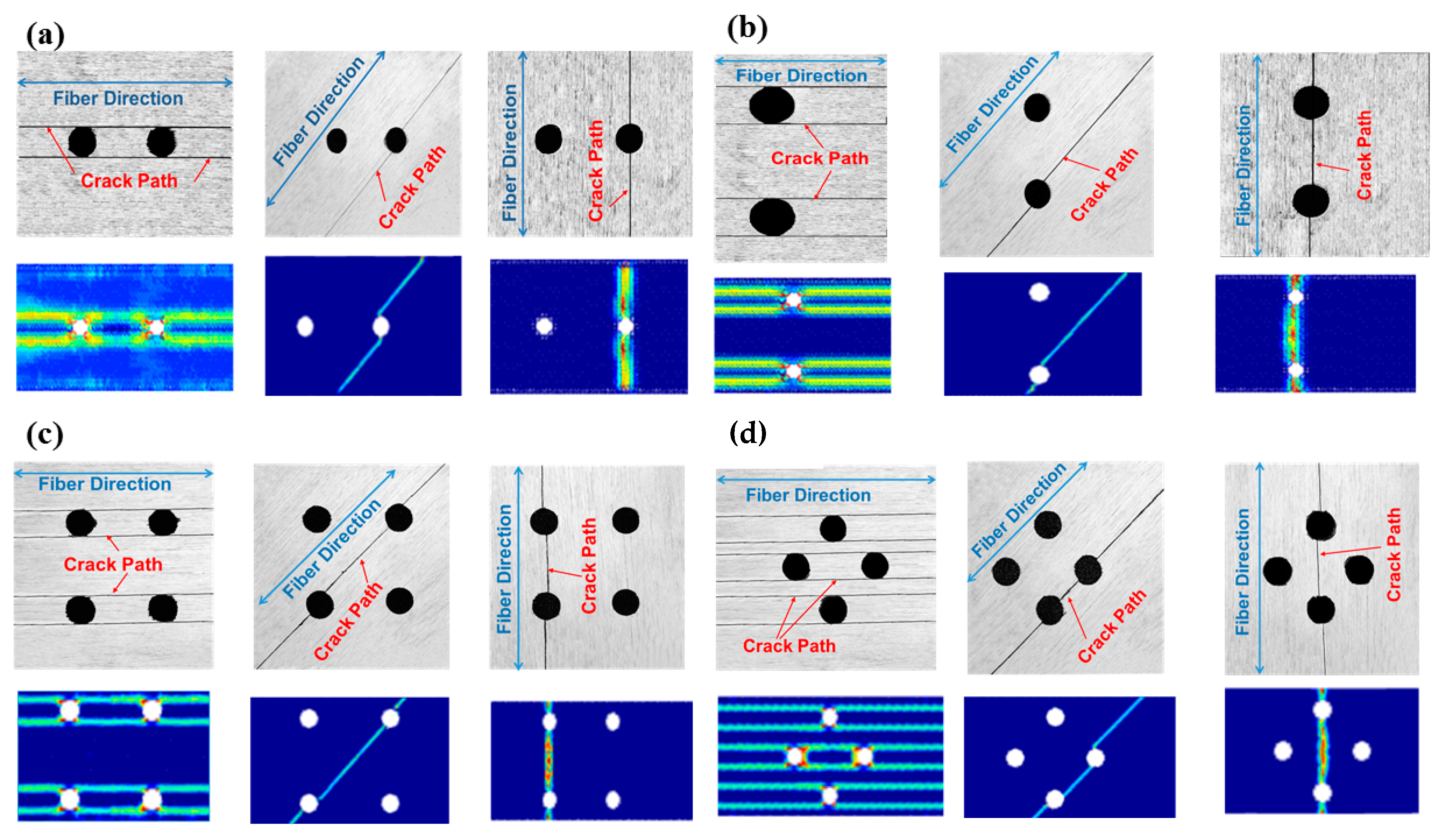

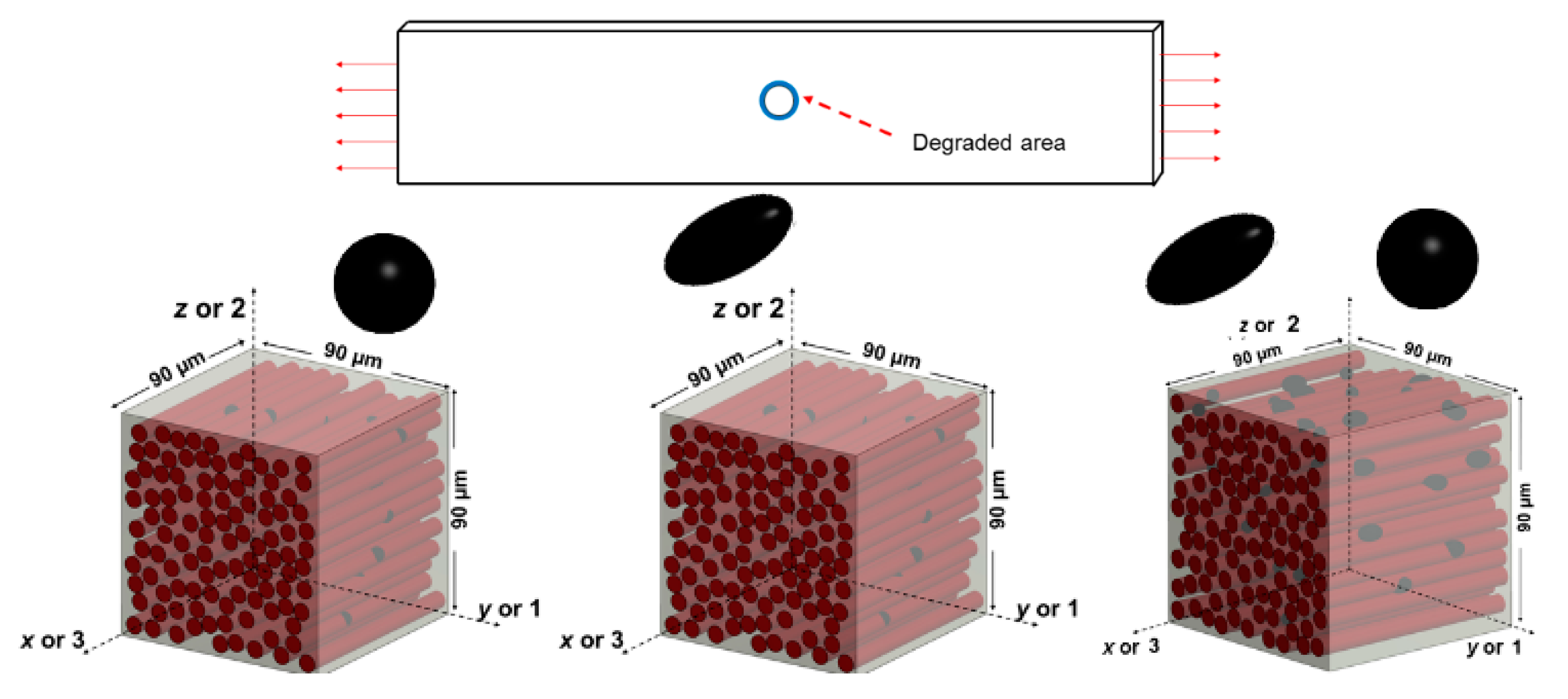
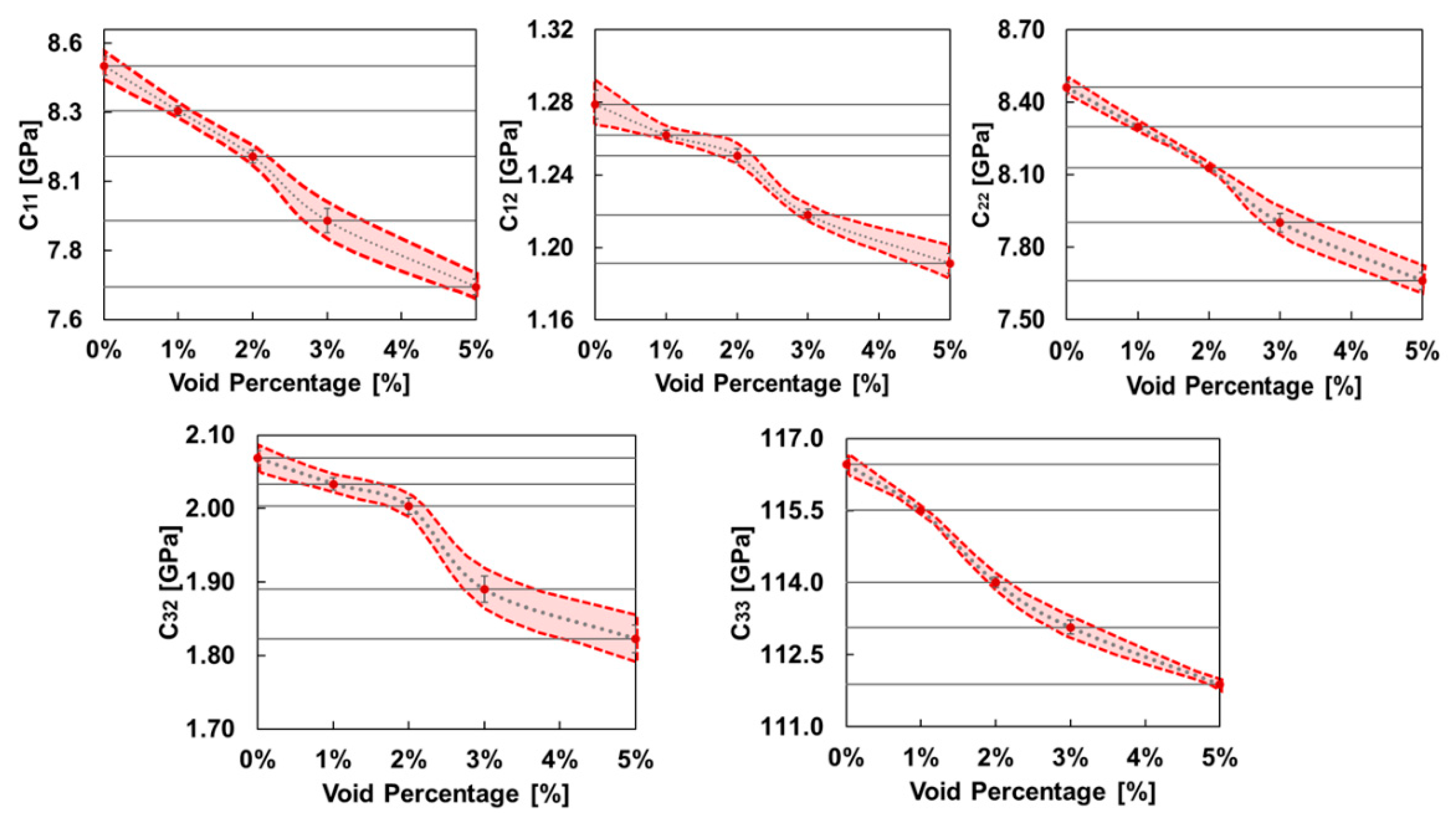

| T 300 Carbon Fiber | Epoxy | |
|---|---|---|
| (GPa) | (GPa) | (GPa) |
| 230 | 15 | 5 |
| Hole Orientations | Fiber Direction | Failure Loads (N) |
|---|---|---|
| One hole | 45 | 3136 |
| 90 | 1797 | |
| Two horizontal holes | 45° | 1975 |
| 90° | 1343 | |
| Two vertical holes | 45° | 1868 |
| 90° | 1221 | |
| Four holes with square array | 45° | 1855 |
| 90° | 1141 | |
| Four holes with diamond array | 45° | 1323 |
| 90° | 832 |
| State of Material | C11 (Gpa) | C12 (Gpa) | C22 (Gpa) | C32 (Gpa) | C33 (Gpa) |
|---|---|---|---|---|---|
| Pristine | 8.46 | 1.27 | 8.46 | 2.07 | 116.46 |
| 1% void | 8.30 | 1.26 | 8.30 | 2.03 | 115.50 |
| 2% void | 8.14 | 1.25 | 8.13 | 2.00 | 114.01 |
| 3% void | 7.90 | 1.21 | 7.90 | 1.89 | 113.07 |
| 5% void | 7.6 | 1.19 | 7.66 | 1.82 | 111.89 |
Publisher’s Note: MDPI stays neutral with regard to jurisdictional claims in published maps and institutional affiliations. |
© 2021 by the authors. Licensee MDPI, Basel, Switzerland. This article is an open access article distributed under the terms and conditions of the Creative Commons Attribution (CC BY) license (https://creativecommons.org/licenses/by/4.0/).
Share and Cite
Tavaf, V.; Saadatzi, M.; Banerjee, S. Effect of Defects Part II: Multiscale Effect of Microvoids, Orientation of Rivet Holes on the Damage Propagation, and Ultimate Failure Strength of Composites. J. Compos. Sci. 2021, 5, 112. https://doi.org/10.3390/jcs5040112
Tavaf V, Saadatzi M, Banerjee S. Effect of Defects Part II: Multiscale Effect of Microvoids, Orientation of Rivet Holes on the Damage Propagation, and Ultimate Failure Strength of Composites. Journal of Composites Science. 2021; 5(4):112. https://doi.org/10.3390/jcs5040112
Chicago/Turabian StyleTavaf, Vahid, Mohammadsadegh Saadatzi, and Sourav Banerjee. 2021. "Effect of Defects Part II: Multiscale Effect of Microvoids, Orientation of Rivet Holes on the Damage Propagation, and Ultimate Failure Strength of Composites" Journal of Composites Science 5, no. 4: 112. https://doi.org/10.3390/jcs5040112
APA StyleTavaf, V., Saadatzi, M., & Banerjee, S. (2021). Effect of Defects Part II: Multiscale Effect of Microvoids, Orientation of Rivet Holes on the Damage Propagation, and Ultimate Failure Strength of Composites. Journal of Composites Science, 5(4), 112. https://doi.org/10.3390/jcs5040112







